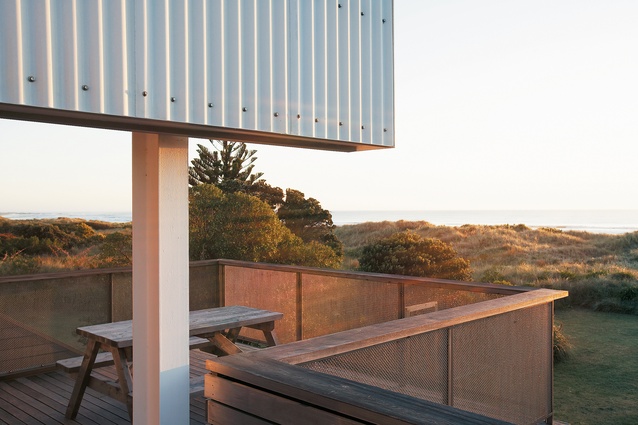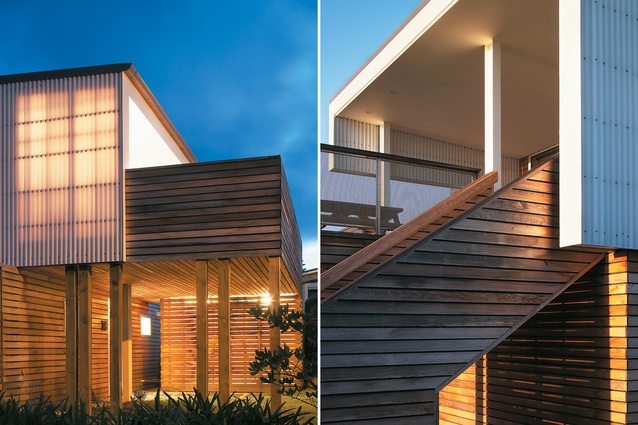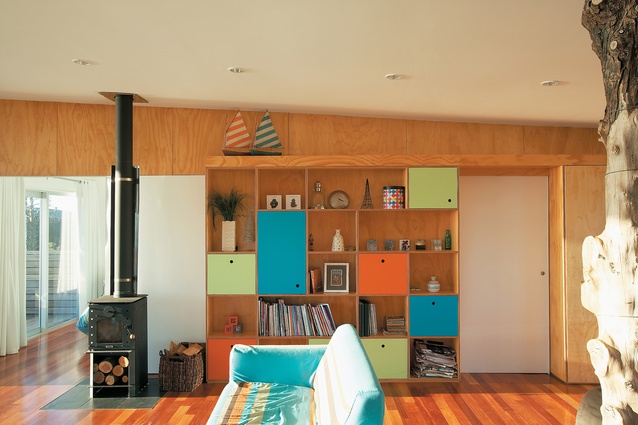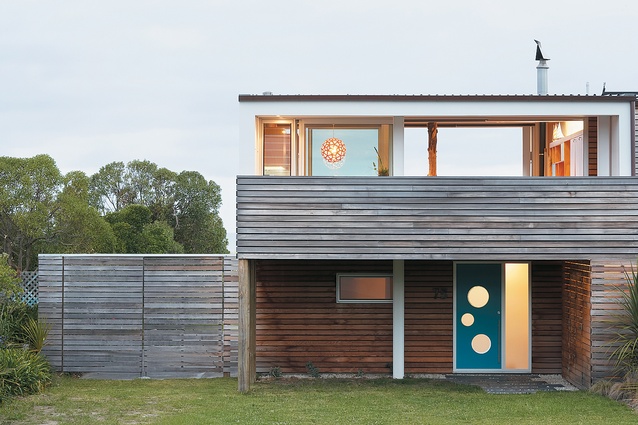Houses Revisited: Like different, man
Andrew Sexton’s reworked bach on the Wairarapa coast is appropriately resistant to modern pretensions in this project from the 2008 archives.
Riversdale is a typical Wairarapa beachside village. In the Wairarapa, the remote, the isolated, the quirky, the defiant, the characterful and the little odd are typical. From Ngawi to Lake Ferry and from Tora to Castlepoint are communities that have spent a little too much time in the wind and not enough in the twenty-first century. (This is a good thing.) Riversdale, like the others, is unlike the others. Relaxed and unruly, it is mostly a single-road town, with baches either side facing a violent sea. The name of the road is Blue Pacific Parade. Riversdale does not want for optimism.
The baches were for the most part built in the middle of the last century and are a long way from town: simple (almost mean) boxes, clad in fibrolite, with shallow gable roofs, nestled in the dunes, occasionally rising up on a concrete basement to peer over the top. Typical. The owners of this bach bought their beachside beauty a few years ago. The upper floor had a living room to the east but the late afternoon sun to the west was blocked by bedrooms. Initially, the owners planned a few minor changes but after spending time with their architect (and relative) Andrew Sexton a full refurbishment developed. The concrete pad and much of the framing was retained, but new steel frames extended and extruded the box, giving considerably more space.

Perhaps the most radical change to the existing fibro box was the organisation of the spaces. The upstairs is now almost exclusively an open living space that opens to decks both east and west. One bedroom stills lurks here but the other four are downstairs with the entry and a flexible kids’ space. The transformation is extraordinary.
The house retains the modesty of the original and offers contemporary living without becoming that monstrosity of modernity, an urban house at the seaside. Our coastal settlements are steadily becoming infected with a virus of glass, steel, Alessi and broadband. Nowhere is immune but the Wairarapa has a healthy number of antibodies, and in the local tradition, Andrew Sexton has blended ’50s restraint, ’60s play and ’70s colour, while eschewing ’90s crassness and twenty-first-century bloat.
The entry is almost vague with the grass road edge fading into concrete pavers with stones between. To the left, a forest of posts holds up the deck above; to the right is a pump shed clad in translucent twinwall and banded cedar battens. At night, illuminated from within, the house becomes a lantern, making a virtue out of utility. The entrance door with its porthole windows allows the afternoon sun to shine across the floor inside, heralding the relaxed nature of the bach. The floor here is cork tile stained black; in contrast, the four bedrooms are clean white boxes with thin white louvres.
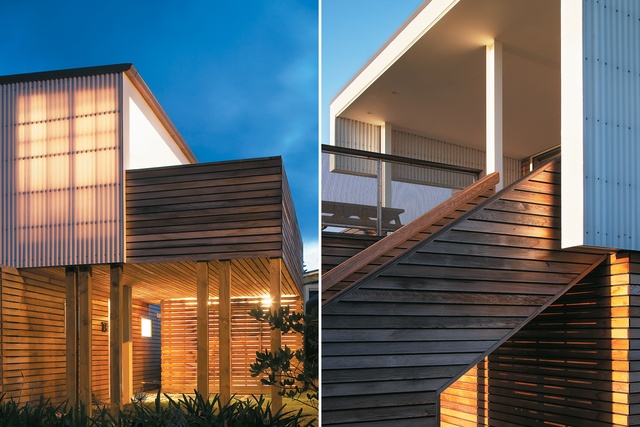
Central to these bedrooms is an ‘anything’ space that opens on to the lawn to the east, big enough for pool or table tennis, small enough to retreat to in the noonday heat or to hold an extra bed when the house gets crowded. The bathroom here is built on the previous bathroom and is big enough to house the laundry and a big sink in which to wash wetsuits and small children. There is storage here, internally for linen and externally for beach paraphernalia, golf clubs, canoes, motorbikes and cray pots. Access to this utility room is from the outside, through a big sliding door.
The cedar-clad stairs to the upper level wind back on themselves. At the top, entry into the living room is through not a wall but a joinery unit. A large sliding door clads the stair side and on the other is a spine of shelves and cupboards which stores just about everything that might be needed in a bach. At the top of the unit, on both sides, are pelmet lights that throw light across the ceiling. Thus the joinery, painted in bright beachy colours, is at once wall, storage, room divider and light fitting: the ultimate in utility.
The upper level is to the north of the storage wall, one big living space. To the south, the best bedroom is at one end; at the other is a bathroom with a double shower, clad in the same blue tiles as the bath downstairs. An electric orange glass shelf harks back to the ’70s.
But the gem of the house is the living space, simply organised but with complex possibilities. The ceiling floats above the decks at either end and continues through the middle, sheltering and unifying the space. The windowless kitchen is on the north wall, which stands solid against the prevailing wind. Made simply of ply with a blue splashback it injects colour into the room; an island defines its boundary. The dining area is an extension of the kitchen with a window seat extruded from the kitchen bench. A long low window, adapted from an existing window, gives an uninterrupted view northeast to the rolling surf.
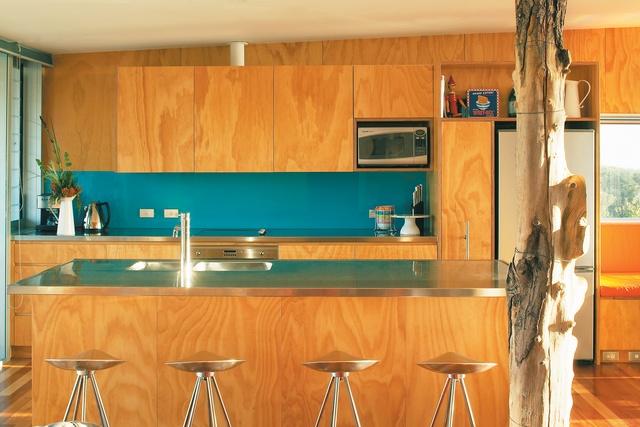
The rest of the space is one big living area with wheeled couches easily rolled into new formations inside, or out onto the decks. The semi-recessed deck to the west grabs the sun in the afternoon and opens itself to the street. This is unusual for Riversdale, where the road bleeds into the verge which dissolves into scrubby vegetation behind which the baches hide. Unusual, and generous.
The eastern deck perched above the deliberately unkempt backyard is wide and generous, sometimes serving as a sleeping porch in the height of summer. The handrail is grunty, clad in cedar and Shadowclad. The protective wall to the north is made of opaque Duralite on both sides; at night, lit from behind, the wall glows. Wide stairs lead to the lawn below which is set in a rugged landscape of dunes, aloes, beach lupins, Norfolk pines, pohutukawa, often washed by sea mist.
This bach belongs here, in Riversdale. It lacks pretension, embraces the dunes, and makes space out of nothing. The materials stand up to the environment without defying it; the spaces open to the world but not the weather. The bach was built for a family, not an award; for lives, not a lifestyle.
Click here to see more Houses Revisited. And sign up to our email newsletters to receive Houses Revisited straight to your inbox.


